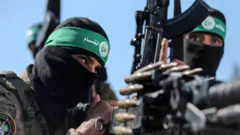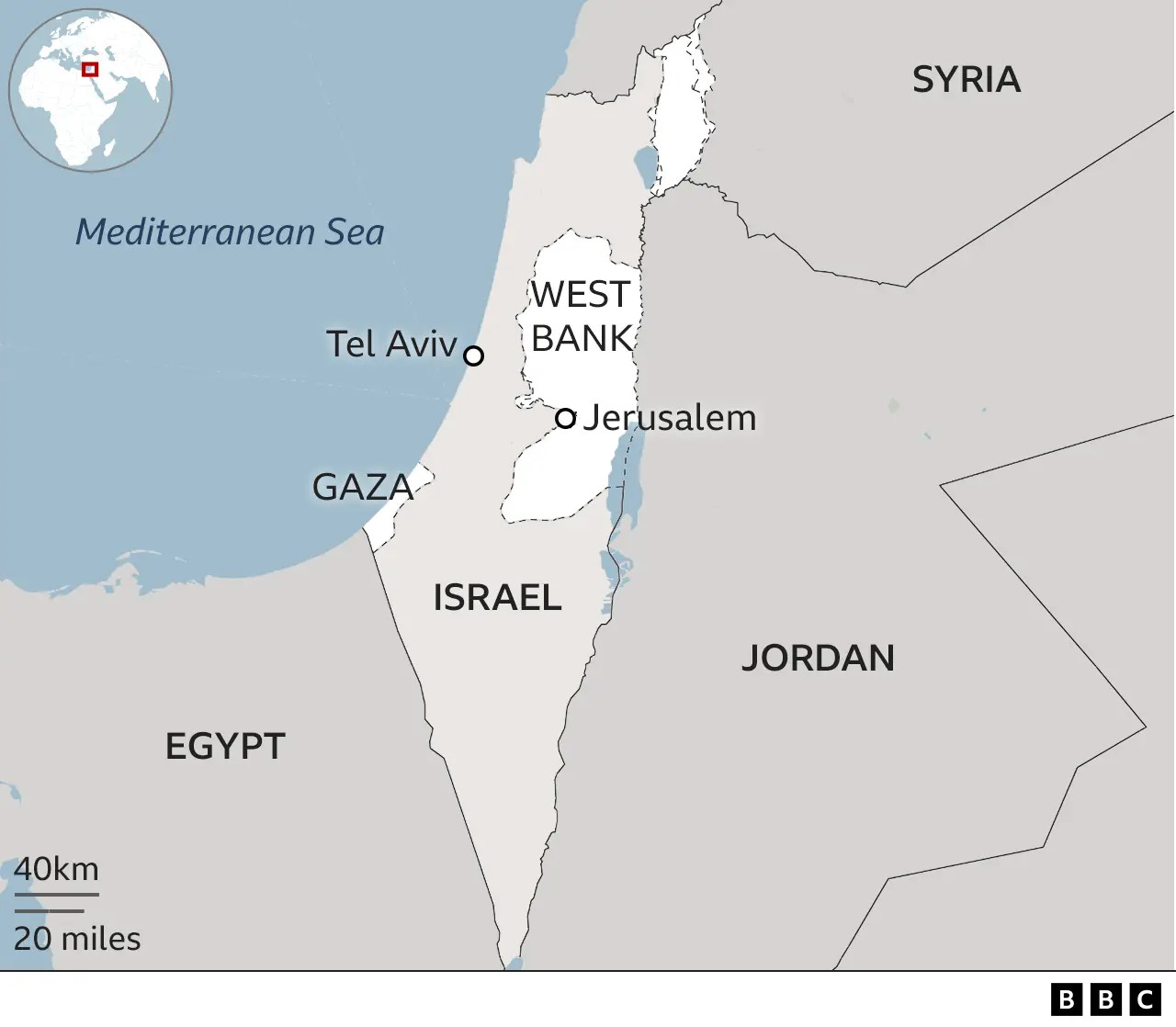Hamas, officially known as the Islamic Resistance Movement, has been a central player in the Israeli-Palestinian conflict for decades. Originating in the late 1980s, this Palestinian Sunni-Islamist fundamentalist organization has significantly shaped the political and geographical landscape of the region. When considering the question “Where Is Hamas Located,” it’s crucial to understand that it encompasses not just a single geographical point, but rather a network of locations that are vital to its political, military, and social operations.
 Getty Images Hamas fighters wearing balaclavas hold weapons
Getty Images Hamas fighters wearing balaclavas hold weapons
Image alt text: Armed Hamas militants in balaclavas, representing the group’s presence in the Gaza Strip.
The Gaza Strip: Hamas’s Primary Geographical Base
The Gaza Strip is undeniably the primary location of Hamas. Since 2007, Hamas has been the de facto ruling authority in Gaza, having taken control after winning the 2006 Palestinian elections and subsequent clashes with rival factions. This coastal territory, bordered by Israel, Egypt, and the Mediterranean Sea, serves as the heartland of Hamas’s operations.
Within Gaza, Hamas has established an extensive infrastructure. This includes:
- Military Infrastructure: A network of underground tunnels is a critical component of Hamas’s military strategy. These tunnels are used for smuggling goods, storing weapons, and launching attacks against Israel. Furthermore, Hamas maintains training camps and military compounds throughout the Gaza Strip.
- Political and Administrative Centers: Government buildings, administrative offices, and political meeting locations are situated across Gaza City and other urban centers, reflecting Hamas’s governance over the territory.
- Social and Civilian Institutions: Beyond military and political control, Hamas also invests in social services, including charities, schools, and healthcare facilities. This civilian infrastructure enhances its support base within the Gazan population.
However, pinpointing the precise location of Hamas within Gaza is complex. Due to security concerns and the nature of their operations, specific locations are rarely publicly disclosed and are often intentionally obscured or underground. Moreover, the leadership and operational bases are not static, especially given the ongoing conflict and Israeli military actions.
Leadership Hubs: Qatar and the Diaspora
While the Gaza Strip is the core operational area, Hamas’s leadership is geographically dispersed. A significant leadership hub exists outside of Palestine, primarily in Qatar.
- Doha, Qatar: For years, Doha has hosted key Hamas political leaders. Historically, Ismail Haniyeh, a prominent figure and former head of Hamas’s political bureau, was based in Qatar. This external base provides a safe haven for leadership, facilitates international communication, and allows for diplomatic engagements. Qatar’s role as a mediator in the region further enhances the significance of this location.
This external leadership base is crucial for:
- Diplomacy and International Relations: Leaders based outside Gaza can engage in diplomatic talks, negotiate ceasefires, and manage relationships with international actors.
- Fundraising and Financial Operations: External locations can facilitate fundraising activities and manage financial networks that support Hamas’s operations in Gaza.
- Media and Public Relations: Leaders in places like Qatar can more easily manage media relations and disseminate the group’s message to a global audience.
Beyond Qatar, other locations in the Palestinian diaspora and allied countries may also host Hamas figures and contribute to the organization’s broader network.
Operational Reach: West Bank and East Jerusalem
While Gaza is Hamas’s stronghold, its influence and operational ambitions extend to other Palestinian territories, particularly the West Bank and East Jerusalem.
- West Bank: Hamas maintains a presence in the West Bank, although it is less overt than in Gaza due to the presence of the Palestinian Authority and Israeli security forces. Hamas cells and networks operate in the West Bank, involved in recruitment, fundraising, and occasionally, attacks against Israeli targets. The level of activity varies depending on Israeli and Palestinian Authority security measures.
- East Jerusalem: East Jerusalem, a highly sensitive and contested city, is also an area of interest for Hamas. The Al-Aqsa Mosque compound, located in East Jerusalem, holds immense religious significance, and Hamas has frequently cited its defense as a motivation for its actions. Hamas seeks to exert influence in East Jerusalem, both politically and potentially operationally.
However, Hamas’s operational capabilities in the West Bank and East Jerusalem are constrained by:
- Security Operations: Intense security cooperation between Israel and the Palestinian Authority in the West Bank limits Hamas’s ability to operate openly.
- Geographical Separation: The physical separation between Gaza and the West Bank poses logistical challenges for command and control and the movement of personnel and resources.
International Connections: Iran and Allies
Understanding “where is Hamas located” also requires acknowledging its international alliances and support networks. Iran is considered Hamas’s most significant international ally.
- Iran: Iran provides Hamas with financial aid, weapons, training, and political support. This relationship is crucial for Hamas’s military capabilities and regional influence. While not a physical location of Hamas itself, Iran’s support base is a critical external factor in understanding Hamas’s strength and operations.
This international support network contributes to Hamas by:
- Providing Resources: Financial and military aid from Iran and other sources bolster Hamas’s capabilities.
- Offering Political Backing: International allies can provide diplomatic support and legitimacy to Hamas’s political positions.
- Facilitating Training and Expertise: External support can include training and the transfer of military expertise.
 Reuters Ismail Haniyeh and Yahya Sinwar
Reuters Ismail Haniyeh and Yahya Sinwar
Image alt text: A composite image of former Hamas leader Ismail Haniyeh and Yahya Sinwar, illustrating key figures within the organization who have operated from various locations.
The Strategic Importance of Location for Hamas
The geographical distribution of Hamas’s locations is not arbitrary but strategically crucial for its survival and operations.
- Gaza as a Protected Base: Controlling Gaza provides Hamas with a territorial base from which to operate, launch attacks, and govern. The dense population and urban environment of Gaza present challenges for Israeli military operations, providing a degree of protection for Hamas infrastructure.
- External Leadership for Continuity: Having leadership figures based outside of Gaza, particularly in Qatar, ensures the continuity of the organization even if its Gaza-based leadership is targeted. It also allows for external engagement and fundraising, vital for long-term sustainability.
- West Bank and East Jerusalem for Expansion and Influence: Maintaining a presence in the West Bank and seeking influence in East Jerusalem allows Hamas to project itself as a national Palestinian movement, not just a Gaza-based group. It also keeps the broader Palestinian issue at the forefront.
- International Alliances for Support and Resources: International alliances, particularly with Iran, provide vital resources and political backing that are essential for Hamas’s operations and its ability to challenge Israel.
The Evolving Location Landscape
The locations associated with Hamas are not static. Ongoing conflict, political changes, and security pressures constantly reshape the geographical landscape of Hamas’s operations.
- Impact of Conflict: Israeli military operations in Gaza directly target Hamas infrastructure and leadership within the Strip. This leads to a constant adaptation and relocation of Hamas assets and personnel. Leadership figures have been targeted and killed, as referenced in the original article with Ismail Haniyeh and Yahya Sinwar, forcing changes in command structures and locations.
- Shifting Political Dynamics: Changes in regional politics, such as shifts in relations between Qatar and other countries, or changes in Iranian policy, can impact the security and viability of Hamas’s external locations.
- Technological Evolution: The use of technology, particularly communication technologies and cyber capabilities, may reduce the reliance on physical locations for certain aspects of Hamas’s operations, while simultaneously creating new virtual locations of operation.
Conclusion: A Networked Organization Across Locations
In conclusion, when asking “where is Hamas located,” the answer is multifaceted. Hamas is not confined to a single point but exists as a networked organization operating across various locations:
- Gaza Strip: The primary operational and territorial base, housing military, political, and social infrastructure.
- Qatar and Diaspora: External leadership hubs for diplomacy, fundraising, and international relations.
- West Bank and East Jerusalem: Areas of operational reach and influence, though constrained by security measures.
- Iran and Allied Nations: International support bases providing resources and political backing.
Understanding this geographical distribution is crucial for comprehending Hamas’s strategies, capabilities, and its enduring role in the Israeli-Palestinian conflict. The question of “where is Hamas located” is not just about physical geography, but about understanding the complex network that sustains this organization and its multifaceted operations.
 Map showing Israel and the Palestinian Territories and surrounding countries
Map showing Israel and the Palestinian Territories and surrounding countries
Image alt text: Map of Israel and Palestinian Territories, visually contextualizing Gaza Strip’s location in relation to surrounding regions relevant to Hamas’s operations.

